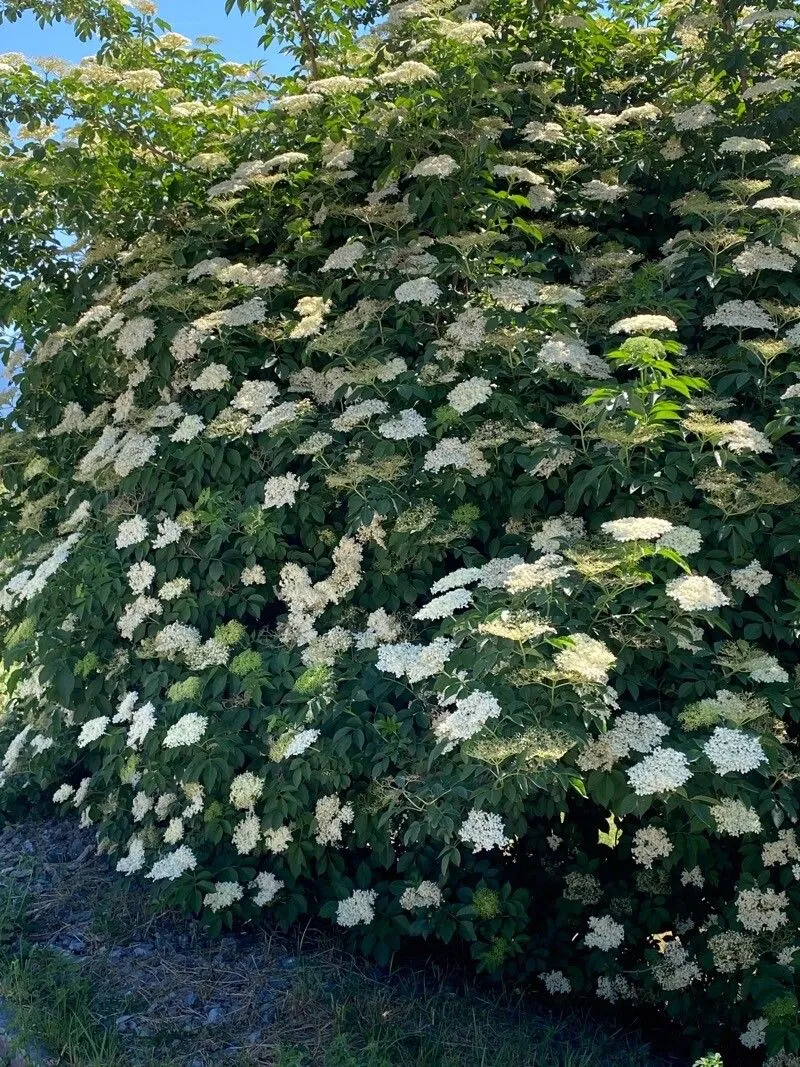
Author: L.
Bibliography: Sp. Pl.: 269 (1753)
Year: 1753
Status: accepted
Rank: species
Genus: Sambucus
Vegetable: False
Observations: N. America to Venezuela and Bolivia
The Canadian elder, scientifically known as Sambucus canadensis, is a versatile and resilient plant that is integral to a wide range of ecosystems and holds cultural importance in various communities across the Americas. First described in ‘Species Plantarum’ in 1753 by the eminent botanist Carl Linnaeus, this species is a cherished member of the Viburnaceae family.
Growing naturally from North America down through Central America to Venezuela and Bolivia, the Canadian elder thrives in a myriad of environments, showcasing its adaptability and ecological value. It is typically found in moist areas such as forest edges, along stream banks, and in roadside ditches, where it often forms dense thickets. The plant can reach heights of up to 10 feet with arching, hollow stems and deciduous, compound leaves composed of 5 to 11 leaflets.
In spring and summer, the Canadian elder becomes particularly striking due to its broad, flat clusters of small, white, star-shaped flowers. These fragrant blooms are not only aesthetically pleasing but also magnetically attract a variety of pollinators, including bees and butterflies, contributing significantly to local biodiversity. By late summer, these flowers give way to clusters of dark purple to black berries, which are a vital food source for wildlife such as birds and mammals.
In addition to its ecological benefits, Sambucus canadensis holds substantial ethnobotanical value. Indigenous peoples and early settlers have long utilized various parts of the plant for medicinal purposes, culinary applications, and even as a material for crafting tools and musical instruments. The berries, when properly processed, are transformed into syrups, wines, jellies, and pies, enriching diets with their vitamins and antioxidants.
However, it is essential to handle the plant with care, as some parts, particularly the leaves, stems, and unripe fruits, contain cyanogenic glycosides, which can be toxic if ingested untreated.
Overall, the Canadian elder is a remarkable species embodying both natural beauty and practical utility. Its widespread presence from North America to South America underscores its importance, both ecologically and culturally, in the regions it inhabits.
Eng: american black elderberry, american elder, common elderberry, canada elderberry, white elder
Deu: kanadischer holunder
Spa: sauco de canada
Nld: amerikaanse vlier
Fra: sureau blanc, sirop blanc, sureau du canada
Cym: ysgaw america, ysgawen america, ysgawen borffor
En: Canadian elder, American black elderberry, AMERICAN ELDER, AMERICAN ELDERBERRY, Mexican elderberry, Blue elder, Common elderberry, Canada elderberry, White elder
Ar: خمان كندي
Zh: 加拿大接骨木莓
Cs: Bez kanadský
Nl: Amerikaanse vlier
Et: Kanada leeder
Fr: Sirop blanc, Sureau blanc, Sureau du Canada
De: Kanadischer Holunder
Is: Ameríkuyllir
Ne: कनिकेफूल
Fa: آقطی
Ru: Бузина канадская
Sk: Baza kanadská
Es: Sauco de Canada
Th: พวงไข่มุก
Cy: Ysgawen America, Ysgaw America, Ysgawen Borffor
© copyright of the Board of Trustees of the Royal Botanic Gardens, Kew.
© copyright of the Board of Trustees of the Royal Botanic Gardens, Kew.
© copyright of the Board of Trustees of the Royal Botanic Gardens, Kew.
Taken Jul 1, 2022 by Norman Gedigk (cc-by-sa)
Taken Sep 4, 2022 by Andreas Dubois (cc-by-sa)
Taken Aug 29, 2020 by Paddy Emiliano (cc-by-sa)
Taken Jul 8, 2020 by manu (cc-by-sa)
Taken Aug 26, 2021 by Judicael Jeranaud (cc-by-sa)
Taken May 30, 2022 by C Dawn (cc-by-sa)
Taken May 7, 2022 by Jeanne Botanique (cc-by-sa)
Taken May 7, 2022 by Jeanne Botanique (cc-by-sa)
Taken May 18, 2022 by Jacques Zuber (cc-by-sa)
Taken Aug 21, 2021 by Louise-Zoé JACQUES-SEBASTIEN (cc-by-sa)
Taken May 16, 2022 by 1DNRM (cc-by-sa)
Taken Oct 5, 2022 by Julian Castillo (cc-by-sa)
Taken Jun 4, 2022 by stef dado (cc-by-sa)
Taken May 8, 2017 by Hugo SANTACREU (cc-by-sa)
Taken May 18, 2022 by Jacques Zuber (cc-by-sa)
Taken May 12, 2022 by Jacques Zuber (cc-by-sa)
Taken May 20, 2022 by Jacques Zuber (cc-by-sa)
Taken Jul 1, 2022 by Tim Skibik (cc-by-sa)
Taken Nov 20, 2022 by philsky Massi (cc-by-sa)
Taken May 18, 2022 by Jacques Zuber (cc-by-sa)
Taken May 17, 2022 by Marcel Schol (cc-by-sa)
Taken May 13, 2022 by Plantae Lucorum (cc-by-sa)
Taken Aug 23, 2021 by Sébastien TRASBOT (cc-by-sa)
Taken Nov 20, 2022 by philsky Massi (cc-by-sa)
Taken Nov 23, 2022 by Dailly Mathilde (cc-by-sa)
Taken May 17, 2022 by Maria Soler Capdevila (cc-by-sa)
Growth form: Multiple Stem
Growth habit: Tree, Shrub
Growth rate: Rapid
Ph maximum: 8.9
Ph minimum: 5.0
Family: Myrtaceae Author: (F.Muell.) K.D.Hill & L.A.S.Johnson Bibliography: Telopea 6: 402 (1995) Year: 1995 Status:…
Family: Rubiaceae Author: Pierre ex A.Froehner Bibliography: Notizbl. Bot. Gart. Berlin-Dahlem 1: 237 (1897) Year:…
Family: Sapindaceae Author: Koidz. Bibliography: J. Coll. Sci. Imp. Univ. Tokyo 32(1): 38 (1911) Year:…
Family: Asteraceae Author: A.Gray Bibliography: Pacif. Railr. Rep.: 107 (1857) Year: 1857 Status: accepted Rank:…
Family: Fabaceae Author: Medik. Bibliography: Vorles. Churpfälz. Phys.-Ökon. Ges. 2: 398 (1787) Year: 1787 Status:…
Family: Aspleniaceae Author: (Cav.) Alston Bibliography: Bull. Misc. Inform. Kew 1932: 309 (1932) Year: 1932…